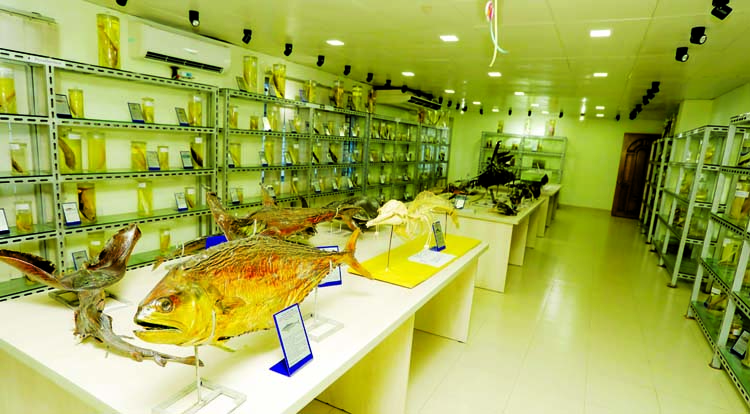
Staff Reporter :
The Faculty of Fisheries of Chattogram Veterinary and Animal Sciences University (CVASU) has developed a fisheries museum with a view to acquainting the students and the researchers with the fisheries resources of Bangladesh.
The teachers of the faculty said, the museum would also be very helpful for the students and teachers of the Faculty of Fisheries, scientists and professionals who want to work about the changes and the reflections with the fisheries resources of Bangladesh.
Its objectives are to guarantee the conservation, protection and safeguarding of the collections of the Museum, to promote research on the maritime and fishery aspects and to contribute to raising awareness towards sustainability, they said.
In this way, the Fisheries Museum shows the history of the elemental relationship between Man and the sea with an open, participatory and interpretative format, enabling visitors to feel part of a story that centers on fish and fishing, one which will leave them with a new way of viewing this ancient, seafaring trade, they added.
The museum has been developed under a subproject the of Higher Education Quality Enhancement Project (HEQEP). The title of the subproject is “Capacity building of the newly established Faculty of Fisheries and strengthening internship program of Faculty of Veterinary Medicine at CVASU for producing competent graduates.
Dr Mohammed Nurul Abser Khan, Professor of the Faculty of Fisheries and SPM of the subproject mentioned that they were able to establish the unique fisheries museum despite being one of the youngest member of fisheries education in Bangladesh due to the funding from HEQEP. Unless HEQEP came forward with the fund it was not possible for us to develop this unique and resourceful museum with our own fund, he said.
He also mentioned that the university authority also extended sincere cooperation to establish the museum. The University offered 3100 Squire Feet area at the ground floor of Fisheries Faculty building for the museum. The museum building is divided into four sub-sections namely Freshwater corner which is enriched with about 150 freshwater fish species, model of modern and integrated fish farms, skeleton of freshwater fishes etc. The second corner is for 200 marine fish species, skeletal of sharks, birds and turtle, staffed rays, shrimps, crabs and lobsters. Among last two sub-sections, one is for the shells and corals of Bangladesh and another one is for the aquatic weeds.
While talking about the uniqueness of the museum he said that this was only the combined fisheries museum in Bangladesh while there were two other museums in Bangladesh; one at Bangladesh Agricultural University, Mymensingh which comprised only freshwater species and another one in Bangladesh Fisheries Research Institute which comprisesd few marine species only.
“While entering in the museum you can see the overall model of the museum and a fountain. There is also a lagre aquarium inside the museum which is rich in many live fishes, live turtle and the aquarium is a center of model ecosystem of the lentic habitat. Upon the corridor of the museum there are different types of traditional fishing boats, fishing knots, traditional passive and wounding gears” SPM of the subproject further said.
Species of this museum have been collected from diffreent parts of Bangladesh. Most of the marine fish species, shells and seeweeds were collected from the coastal areas of Bangladesh like Cox’s Bazar, Chattogram, Khulna regions and Saint Martin’s island. Freshwater species were collected fromdifferent districts of Bangladesh upon the availibility of the species.

